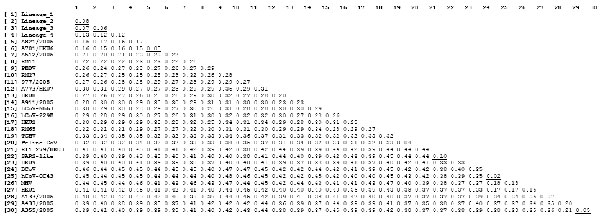Volume 14, Number 4—April 2008
Research
Detection and Prevalence Patterns of Group I Coronaviruses in Bats, Northern Germany
Appendix Figure

Appendix Figure. Nucleic acid distances in a 334-bp fragment of ORF1b retrievable from most coronaviruses. Pairwise nucleic acid distances in the 334-bp core fragment of ORF1 that has been completely entered in GenBank for most coronaviruses from a 440-bp amplification product. Distances between prototype bat coronaviruses or type strains of established mammalian coronavirus species of groups I and II are shown. Names of type strains or bat coronavirus prototype strains are shown in the left column. Distance values <0.1 are underlined.
Page created: July 16, 2010
Page updated: July 16, 2010
Page reviewed: July 16, 2010
The conclusions, findings, and opinions expressed by authors contributing to this journal do not necessarily reflect the official position of the U.S. Department of Health and Human Services, the Public Health Service, the Centers for Disease Control and Prevention, or the authors' affiliated institutions. Use of trade names is for identification only and does not imply endorsement by any of the groups named above.